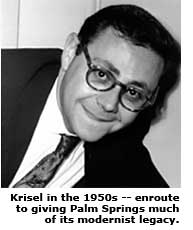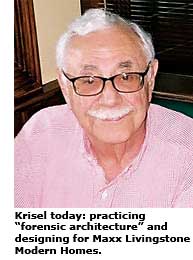Bill Krisel Interview

In Palm Springs, William Krisel, along with former partner Dan Palmer, is famous for designing modern tract homes with flat, butterfly, or folded-plate roofs, open plans, and decorative concrete block walls. Palmer & Krisel's client, George and Robert Alexander, developed the homes from 1955 to 1965, giving the town much of its modernist legacy.
But in a career that's approaching 60 years, Krisel did much more, including modern tracts in San Diego, subsidized housing in San Francisco's Hunter's Point, apartments, and high-rise condominiums and offices throughout the state.
Today, Bill is still designing houses for Palm Springs. He has licensed updated versions of his mid-'50s Alexander homes -- a larger master bathroom, more open kitchen, double-glazed glass, ample insulation, just as much glass -- to Maxx Livingstone Modern Homes. The firm is building on individual clients' lots and may do a small subdivision as well.
He remains active in the profession, with a second career in what he calls "forensic architecture," helping defend architects in lawsuits. Bill recently spoke for several hours with CA-Modern in the house he designed in 1954 in the Brentwood district of Los Angeles. This is the first part of our interview.
Q: In the beginning of your career, was your work primarily residential?
WK: Actually, the first job I brought into Palmer & Krisel wasn't a residence but a shopping center in the valley. It got built, and we thought we were going to have a big career in shopping centers, but it didn't quite take.

When we first started, we mainly did custom houses, and we only did modern. Neither of us knew anything about traditional architecture at all, didn't like it, didn't want to do it, had no feeling about it. It wasn't part of our life. After doing about 15 custom houses, we began to phase into tract houses.
Q: How did you get involved with the Alexanders and with the desert?
WK: We were one of the first architectural firms to do modern tract housing, and that came about because of a good friend of mine named Bob Alexander. Bob lived up here [Brentwood], and we were in the same social circle. His father was a builder. As we became friends and I talked about architecture, he seemed to like my ideas, and he arranged a meeting with his father.
His father thought I was nuts. His father [George Alexander] told Bob they were very successful building what we call 'dingbats.' This was 1952. Dingbats are stucco boxes that have holes in the wall that are called windows.
Bob persisted with his dad, and his dad thought he'd teach him a lesson. He said, "Okay, I have this piece of land that will take eight or ten houses. Why don't you go and do your thing with Bill? Then you'll know what I'm talking about."
So I did these post-and-beam houses, and before they were finished, they were sold. This was way out in the San Fernando Valley, which at that time was considered very far out. They cost less per square foot than what Bob's father sold as dingbats, and they sold at a higher price, so they made a bigger profit per house. At the end of the project, when all the numbers were in, we met with his father. He was very impressed with what we had done.
He immediately turned over another large parcel of land in San Fernando Valley, which we called Corbin Palms because it was off Corbin Avenue. And that is still a flourishing suburb.
There were developers that came from all over America, saw these houses, how unique they were, how well they sold, how much profit there was in them, how people liked them, how they were written up. And our practice flourished. I think we did 20,000 houses in about a five-year period of time, all over San Fernando Valley, Orange County, La Mirada, Buena Park.
We had developed a system of post-and-beam houses, developed our own windows, our own walls. We found out what cost money in a home, and we figured out how to do it better and cheaper.
Q: What were the Alexanders like?
WK: George Alexander did accounting for people doing big tract houses, and he soon discovered they were making a lot of money. And he soon discovered that they [the builders] didn't know much more about it [building] than they [themselves] did. Yet, if you hired a superintendent and went into partnership with him, you could become a big builder.
So he became a builder. And Bob grew up, didn't want to go to college, and he hung around the building sites and he liked building.




